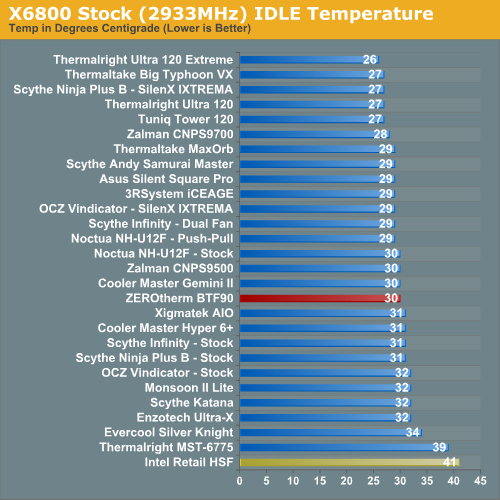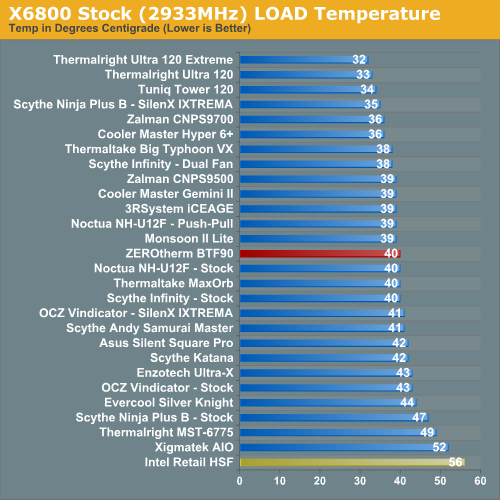ZEROtherm BTF90: Sting like a Butterfly?
by Wesley Fink on August 13, 2007 12:05 AM EST- Posted in
- Cases/Cooling/PSUs
Cooling at Stock Speed
Some users will never overclock their CPU, but they still want to run the coolest CPU temperatures possible to enhance stability and extend CPU life. The ZEROtherm BTF90 uses a 4-pin connector to allow the motherboard to control fan speed. The supplied fan is a standard 92mm size, but it is embedded and not user changeable.

Where the very good Intel stock cooler keeps the X6800 at 41C at idle, the BTF90 manages 30C. This is a significant improvement over the Intel stock cooler performance at 41C, but the results are average among top air coolers tested at AnandTech. The Thermalright coolers, at the top of our heatpipe tower performance charts, cool to 26C and 27C, and the Tuniq 120 maintains 27C. The BTF would likely do better if the fan were run at maximum speed at idle, since the speed is auto controlled by the temperature of the processor. Still, the performance is quite good for a cooler using a 92mm fan running at its slowest speed.
It is more difficult to effectively simulate a computer being stressed by all of the conditions it might be exposed to in different operating environments. For most home users CPU power is most taxed with contemporary gaming. Therefore our stress test simulates playing a demanding game.
The Far Cry River demo is looped for 30 minutes and the CPU temperature is captured at 4 second intervals with the NVIDIA Monitor "logging" option. The highest temperature during the load test is then reported. Momentary spikes are ignored, as we report a sustained high-level temp that you would expect to find in this recording configuration. This test configuration roughly equates to an 80% CPU load test using Intel TAT.
Cooling efficiency of the ZEROtherm BTF90 was then compared under load conditions at stock speed to the retail HSF and other recently tested CPU coolers.

The BTF90 under load at stock speeds reached a maximum temperature of 40C with the included fan at highest auto speed. This compares to the Thermalrights at 32C and 33C, the Tuniq at 34C, and the cooler Master Hyper 6+ and Zalman 9700 at 36C. Stock load performance is average among tested coolers. This is really a very good performance for a cooler using a 92mm fan when you consider that almost every other air cooler tested at AnandTech uses a 120mm fan for cooling.
Some users will never overclock their CPU, but they still want to run the coolest CPU temperatures possible to enhance stability and extend CPU life. The ZEROtherm BTF90 uses a 4-pin connector to allow the motherboard to control fan speed. The supplied fan is a standard 92mm size, but it is embedded and not user changeable.

Where the very good Intel stock cooler keeps the X6800 at 41C at idle, the BTF90 manages 30C. This is a significant improvement over the Intel stock cooler performance at 41C, but the results are average among top air coolers tested at AnandTech. The Thermalright coolers, at the top of our heatpipe tower performance charts, cool to 26C and 27C, and the Tuniq 120 maintains 27C. The BTF would likely do better if the fan were run at maximum speed at idle, since the speed is auto controlled by the temperature of the processor. Still, the performance is quite good for a cooler using a 92mm fan running at its slowest speed.
It is more difficult to effectively simulate a computer being stressed by all of the conditions it might be exposed to in different operating environments. For most home users CPU power is most taxed with contemporary gaming. Therefore our stress test simulates playing a demanding game.
The Far Cry River demo is looped for 30 minutes and the CPU temperature is captured at 4 second intervals with the NVIDIA Monitor "logging" option. The highest temperature during the load test is then reported. Momentary spikes are ignored, as we report a sustained high-level temp that you would expect to find in this recording configuration. This test configuration roughly equates to an 80% CPU load test using Intel TAT.
Cooling efficiency of the ZEROtherm BTF90 was then compared under load conditions at stock speed to the retail HSF and other recently tested CPU coolers.

The BTF90 under load at stock speeds reached a maximum temperature of 40C with the included fan at highest auto speed. This compares to the Thermalrights at 32C and 33C, the Tuniq at 34C, and the cooler Master Hyper 6+ and Zalman 9700 at 36C. Stock load performance is average among tested coolers. This is really a very good performance for a cooler using a 92mm fan when you consider that almost every other air cooler tested at AnandTech uses a 120mm fan for cooling.










19 Comments
View All Comments
RamarC - Tuesday, August 14, 2007 - link
you spelled ali's name wrong. it's "muhammad" not "mohammed" (the prophet).mostlyprudent - Monday, August 13, 2007 - link
Nice article. As has been mentioned, I really like the low noise/high performance combo, but could live without the butterfly (although my daughter would love a pink PC w/ a window and this cooler!).Sometime ago, you mentioned the possibility of a round-up type article of all the coolers tested. I would love to see some fan testing along with that. For example, I would love to see how some of the other coolers (like the Tuniq) perform with quieter/lower output fans). I am always looking for the best combination of low noise & high performance in my builds.
Deusfaux - Monday, August 13, 2007 - link
thanx for the review, I know I had been buggin yeah about doing one on it for sometime.Looks like a pretty decent fit for the girl's rig!
n7 - Monday, August 13, 2007 - link
How's the Coolit Freezone review coming along?Wesley Fink - Monday, August 13, 2007 - link
It is coming after a couple of reviews of some new and unique water cooling products.neogodless - Monday, August 13, 2007 - link
Wow... if I could peel my girlfriend away from her MAC, I'd be asking to build her a computer right now with this heatsink!Also, I think the work you put into your articles is great, and the writing is very good, too. However, I think this particular conclusion dragged on and felt repetitive, like you felt like it had to be long for the sake of longness. Otherwise, good article and interesting product. Sometimes you don't have to be the best... to be the best choice.
Wesley Fink - Monday, August 13, 2007 - link
I reread the conclusion after your comment and basically agree. I cut some of the repeat info paragraphs and condensed the rest. All the conclusion info is still there.neogodless - Monday, August 20, 2007 - link
Ok great - I never want to be unnecessarily critical, but glad to be constructively so. (Posting this now as the new cooler article reminded me to check back.)asliarun - Monday, August 13, 2007 - link
I agree. Nice article!One (free-fart) suggestion: Please try to cater to a wider audience in your conclusions.. as it is the most important part of the article. I get the sense that you try to target the "extreme hardware-hacker/overclocker" crowd while neglecting the "value-for-money" crowd who want to extract good stable performance at reasonable prices. My inference from this article is that this cooler is a very good buy! Cheap, lightweight, silent, middle of the pack performance.. a reasonably rare combination for someone who doesn't spend more on his cooler than his CPU!
For example, I've read most of your cooler articles but still don't know which CPU+Cooler combination would give me the best performance at a given price point.